Images From Nollywood
Pieter Hugo captures the fiction and reality of Nigeria's film industry.
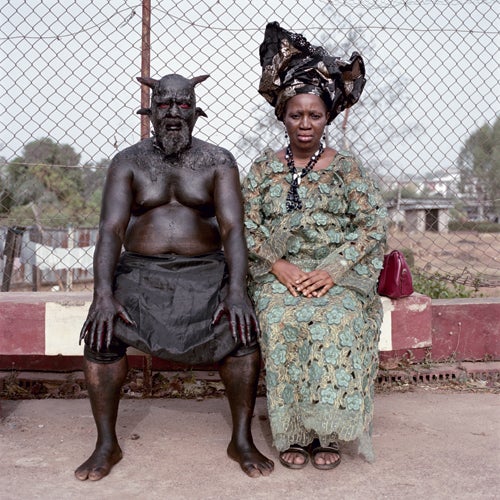
On first look at some of the images in Pieter Hugo’s new book, Nollywood (Prestel, October 2009; $50), you might think that this is a documentary of civil conflict: scarred soldiers in mud-covered uniform, or children sitting in rubble-filled fields. It’s only when you flip to a portrait of a vampire, with red eyes and fangs, or a zombie sipping Coca Cola, that you realize you’re being tricked.
And these images are meant to trick you, but they’re also only halfway between reality and fiction. Nigeria’s ‘Nollywood’, despite its low budgets and straight-to-DVD production, is one of the highest production film industries in the world. Its themes, like the images in this book, are often upernatural and melodramatic, with vampires, militants, and undead children. But though these images star Nigerian actors costumed with help from Nollywood makeup artist Gabazzini Zuo, they aren’t photodocumentary–they’re constructed filmic tableaux. Accompanied by essays by Chris Abani, Stacy Hardy, and Zina Saro-Wiwa (daughter of famed activist Ken Saro-Wiwa), Nollywood aims to unsettle viewers with their own preconceptions, and look deeper into a complex society often stereotyped in Western media.
Q: What first sparked your interest in photographing Nollywood?
As a photojournalist who has worked throughout Africa, I had often run across it. I would go to a bar where a group of people were watching a Nollywood film. And I would always be highly conscious of my disbelief of the movies–I would see lighting equipment sticking out in one corner of the set, and notice ways in which the shot quality would be terrible. But the audience watching it would be completely enthralled, and I think this is because of the authenticity of the stories that they’re telling. Which have very much to do with poverty, human trafficking, Juju. And have a strong resonance also in the way in which they’re filmed and the localities in which they’re set.
Nollywood is one of the first, real instances of a completely self-representational predominant mass media in Africa. These aren’t Western movies, such as a film about Rwanda that’s been shot in another country. They’re on their own terms.
Q: How did it evolve from a documentary project to a staged project?
What interested me wasn’t the film industry itself, but the space that these films inhabit. I knew that I was interested in photographing the actors–the verbal constrictedness, the over-the-topness of it. But when I first went onto a Nollywood set, I wanted to photograph the actors without the directors, without the camera men and the sound guys. And I did initially begin photographing this in a documentary way.
Then I met Gabazzini Zuo, who is one of the most successful makeup artists in Nigeria, and he showed me photographs of work that he’d done on Nollywood sets. And the complexity of these photos made me want to explore it further. As someone who has worked as a photodocumentarian of Africa, I’ve noticed that you have this almost high-paid codicization of the topic. It’s turned onto the viewer in such a way where you look at something like [those images] and go oh, that’s so crazy. Then you realize, hang on, you know what’s crazy about this is my baggage that I’m bringing onto it. This is totally staged. It was somewhere between constructivist and documentary.
Zuo suggested that we stage these tableaux and recreate them, to document the representation. This is what eventually became the book, though it evolved in a way that I hadn’t expected.
Q: It’s interesting how it sounds in the introduction as if your own shoots were as spontaneous as Nollywood film shoots.
I thought it was important to bring spontaneity and freshness, have an almost amateurish quality, so that it stays believable. Nollywood films go from production to postproduction at an incredible speed. On sets the day of the shooting, often the actors don’t really know what the subject is. The whole production of internalizing the character doesn’t take place.
I worked with somewhere between 80 to 100 actors. Some were very experienced, and came from a theater background, and some of them were aspiring actors. Some people definitely got more out of it and put more of themselves into the pictures. Some would refuse to do a type of scene and then suggest a different one. But the props we used, and a lot of the scenes that were staged, were very derivative of Nollywood films.
Q: Where did you get the ideas?
They’re from all over. At the time I had this book with me from Umberto Eco, and there’s also one scene that’s very much inspired by a Francis Bacon painting. J.M. Coetzee: Elizabeth Costello, and Diary of a Bad Year. I’ve always been really influenced by J.G. Ballard and David Cronenburg.
But a lot of it came spontaneously, and was very organic. I’d say: Tomorrow, we need to find two men with machine guns. And then by lunchtime the next day we would have two women in bathrobes, covered in blood.
Q: What did you learn by doing a project that is so different from your photodocumentary work?
When you start out on something as a photojournalist on assignment, there’s a point at which what you’re doing is totally subjective. What you decide to say by a photograph is defined as much by what you decide to include in the photograph, as a viewer might decide to conclude from the frame. I have been doing this for years and have only recently been conscious of it. So this wasn’t all that different from the photographs I took in adolescence, or even from how I constructed certain photographs from Rwanda. What comes out in these photographs is always your own preoccupations. But to be completely honest about your intentions…
Q: And what are those intentions? What are your hopes for Nollywood?
Africa is a very complex continent. Part of the problem with the West’s engagement with Africa is partially-engineered stereotype. I want Nollywood to be an acknowledgement of the complexity of it, so that viewers accept something outside of just the representation. And I would like them to think about the politics of that: the space between what you see and what they see.
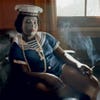
BundesMarine
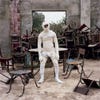
Mummy
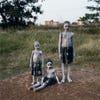
Zombie-Children
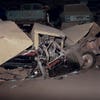
Carwreck
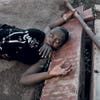
Hand-in-mouth
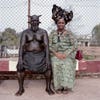
Devil-couple